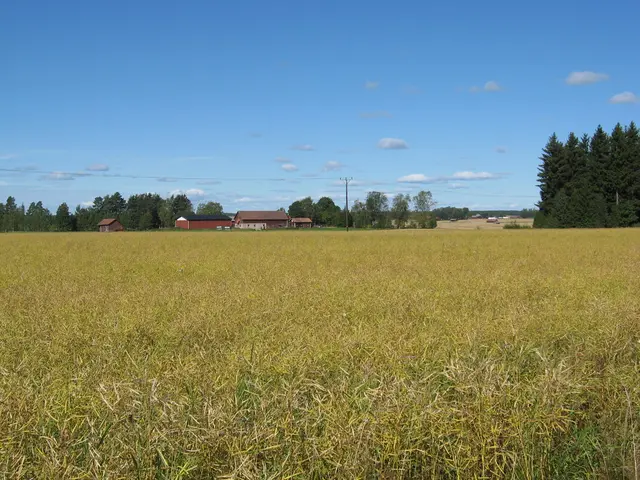Guidelines for Crafting Sustainable Habitats: Engineering Resilient Natural Environments
Permaculture is all about creating harmonic ecosystems that not only survive, but thrive. It's a design philosophy focused on mimicking patterns and relationships found in nature, bringing together land, resources, people, and the environment in a way that benefits everyone involved. Here are the principles that guide the creation of theseSelf-sufficient and regenerative ecosystems:
- Observation and Interaction
- Take time to understand the natural environment before making any changes.
- Catalogue how sunlight, water flow, wind patterns, and existing flora and fauna interact with one another and craft systems that harmonize with Mother Nature instead of standing in opposition to her.
- Energy Efficiency
- Harness renewable energy sources like sunlight, wind, and water.
- Store energy in forms like thermal mass, water reservoirs, and food production, so you have what you need when you need it.
- Productivity
- Streamline system designs to provide tangible benefits like food, water, and energy while supporting ecological health.
- Ensure that every single component plays a role in enhancing productivity, aiming for a state of abundant self-sufficiency.
- Adaptability and Feedback
- Regularly monitor and evaluate your systems to identify inefficiencies or imbalances.
- Employ feedback tactics that lessen waste and overuse of resources, while promoting sustainability and natural checks and balances, like predator-prey relationships.
- Renewable Resource Prioritization
- Lean more on renewable resources such as solar energy, rainwater, and compost compared to finite materials.
- Champion ecosystem services like pollination by bees or nutrient cycling by soil organisms to reduce reliance on external inputs, and foster natural processes.
- Minimal Waste
- Foster a culture of "waste as a resource."
- Craft closed-loop systems where outputs from one process serve as inputs for another, like using kitchen scraps for compost.
- Pattern-Based Design
- Start with broad natural patterns (e.g., seasonal cycles or landscape contours) before honing in on specific design elements.
- Align designs with natural rhythms for efficiency, planting based on sun exposure or rainfall patterns as examples.
- Integration over Segregation
- Combine elements in ways that breed mutually beneficial relationships (e.g., planting companion crops).
- Embrace diversity within ecosystems to enhance resilience against pests or environmental changes.
- Gradual Solutions
- Emphasize small-scale, incremental changes that are easy to manage and adapt over time.
- Encourage evolution in your systems rather than forcing rapid adjustments.
- Embracing Diversity
- Cultivate a varietal landscape by growing different species of plants, animals, and microorganisms.
- A diversified ecosystem exhibits increased resilience to pests, diseases, and fluctuations in climate.
- Leveraging Marginal Areas
- Utilize transitional spaces between ecosystems, where biodiversity runs rampant.
- Recognize the potential held by neglected areas and quirky ideas to enrich productivity.
- Change and Creativity
- See alterations as opportunities for progress rather than insurmountable challenges.
- Craft flexible systems that can adapt to evolving environmental or societal conditions, fostering innovation amidst change.
By weaving these principles together with a value system centered on caring for the Earth, caring for people, and fair share (future care), permaculture design gives rise to ecosystems that promote sustainability while fostering unique bonds between people and the planet. It's all part of working in harmony with nature, rather than against her.
From a high level, these twelve principles can be broken down into three core elements:
- Cultivate knowledge of the natural world, understanding the patterns and relationships that occur within it.
- Rely on renewable resources and harness energy in ways that benefit both the environment and human needs.
- Foster closeness between ecosystems and prioritize biodiversity, ensuring the resilience and adaptability of these Self-sufficient and regenerative environments.
Sources:- 1. Principles of Permaculture- 2. History and Fundamentals of Permaculture- 3. Nine Key Principles of Permaculture- 4. The 12 Fundamental Principles of Permaculture- 5. Permacriculture and Sustainable Urban Development
- Incorporating the principles of permaculture, one can create a home-and-garden that not only serves as a living space, but also exemplifies sustainable living, such as by utilizing renewable energy sources, minimizing waste, and cultivating a diverse ecosystem.
- Within the context of home-and-garden design, adhering to permaculture principles can lead to a lifestyle that supports self-sufficiency and regenerative ecosystems, promoting a harmonious relationship with nature while ensuring the long-term sustainability of resources.








